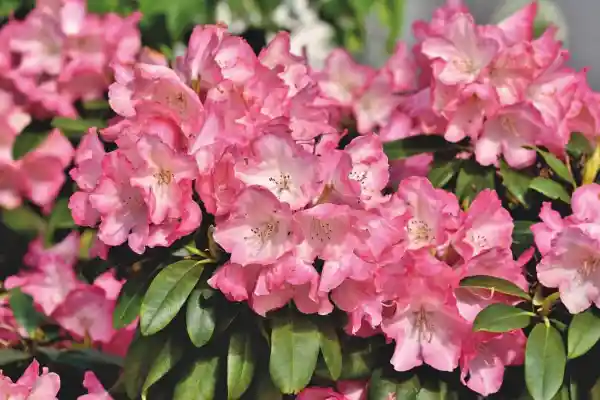Rhododendrons, known for their stunning flowers and lush evergreen foliage, are popular ornamental plants in many gardens. To successfully cultivate these beautiful shrubs, it’s important to understand their specific requirements and care. In this expert guide, we’ll provide comprehensive instructions on how to grow rhododendrons, referencing information from reputable government bodies, horticultural organizations, and academic experts.
Introduction to Rhododendrons
Rhododendrons are versatile and vibrant shrubs known for their attractive blooms and year-round greenery. They come in various species and cultivars, making them suitable for a range of garden settings.
Selecting the Right Rhododendron Variety
Consult local horticultural experts or the United States Department of Agriculture (USDA) plant hardiness zone map to choose Rhododendron varieties that are well-suited to your region. Different species and cultivars vary in size, shape, and flower color.
Choosing the Ideal Planting Location
Rhododendrons thrive in partial to dappled shade, as well as well-drained, acidic soil with good organic content. Select a location that provides these ideal conditions and shelter from harsh afternoon sun.
Planting Rhododendrons
Follow these steps when planting Rhododendrons:
Timing
Plant in the early spring or fall when the weather is cool and the ground is moist.
Depth
Plant the rhododendron at the same depth as it was in the container or with the root ball level with the soil surface. Proper depth is crucial for healthy growth.
Spacing
Ensure sufficient space between plants to allow for mature growth, following the recommendations specific to the variety.
Proper Care and Maintenance
To ensure lush growth and vibrant blooms:
Watering
Keep the soil consistently moist but not waterlogged, especially during dry spells. Avoid overhead watering to prevent fungal diseases.
Mulching
Apply a layer of organic mulch around the base of the plant to retain moisture and regulate soil temperature.
Fertilization
Rhododendrons benefit from regular feeding with a balanced, acid-loving plant fertilizer to maintain their vigor and color.
Pruning and Deadheading
Prune rhododendrons to remove dead or diseased branches and spent flowers. Avoid heavy pruning, as this can hinder flowering.
Pest and Disease Management
Rhododendrons may encounter pests like lace bugs or diseases like powdery mildew. Consult resources from the National Plant Board and the American Horticultural Society for guidance on identification and management.
Winter Protection
In colder regions, provide winter protection with burlap or evergreen boughs to shield the shrubs from harsh winds and cold temperatures.
Resources for Further Information
For comprehensive knowledge and expert advice on growing Rhododendrons, explore resources from horticultural experts and institutions, including:
United States Department of Agriculture (USDA)
www.usda.gov
Agricultural Cooperative Extension
Contact your local extension office for personalized guidance and resources.
What are Rhododendrons, and why are they popular in gardens?
Rhododendrons are ornamental shrubs known for their stunning flowers and evergreen foliage, making them a favorite choice for gardeners.
How can I choose the right Rhododendron variety for my region and garden?
Consult local horticultural experts or the USDA plant hardiness zone map to determine the Rhododendron varieties suitable for your area, considering their size, shape, and flower color.
What are the sunlight and soil requirements for Rhododendron cultivation?
Rhododendrons thrive in partial to dappled shade and well-drained, acidic soil with good organic content. Avoid harsh afternoon sun.
When is the best time to plant Rhododendrons, and how should I space them?
Plant Rhododendrons in early spring or fall, spacing them according to the variety’s recommendations to allow for mature growth.
What is the recommended watering schedule for Rhododendrons, and how can I avoid overwatering?
Keep the soil consistently moist, avoiding waterlogged conditions. Use a drip irrigation system or soaker hose to ensure even moisture.
Why is mulching important when growing Rhododendrons, and what type of mulch should I use?
Mulching with organic mulch helps retain moisture, regulate soil temperature, and control weeds around the base of the plant.
Do Rhododendrons face common pest and disease issues, and how can I manage them?
Rhododendrons can encounter pests like lace bugs and diseases like powdery mildew. Consult resources from the National Plant Board and the American Horticultural Society for guidance.
Is pruning necessary for Rhododendrons, and how should I go about it?
Prune Rhododendrons to remove dead or diseased branches and spent flowers. Avoid heavy pruning, as this can affect flowering.
What are some winter protection measures for Rhododendrons in colder regions?
Provide winter protection with burlap or evergreen boughs to shield Rhododendrons from harsh winds and cold temperatures.
Where can I find more information and expert resources on growing Rhododendrons?
Explore resources from the USDA and contact your local Agricultural Cooperative Extension for personalized guidance and horticultural expertise on cultivating Rhododendrons.
- Best THC Sodas to Buy in Arkansas - May 28, 2025
- Exploring THC-Infused Sodas in Arkansas - May 28, 2025
- THC Beverages Now Trending in Alabama - May 28, 2025




